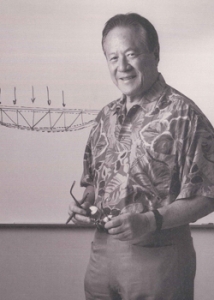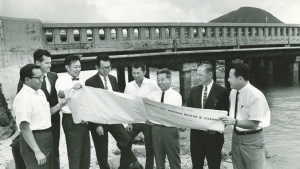A pair of anonymous $1 million gifts from the same donor to the University of Hawaiʻi at Mānoa’s College of Engineering establishes the college’s first endowed chair in honor of world-renowned Hawaiʻi engineer Alfred A. Yee. Yee helped design some of Honolulu’s most complex structures, from Alfred Preis’s floating Arizona Memorial to Ossipoff’s Diamond Head Apartments, the first precast, prestressed concrete tower in the country.

UH President David Lassner said, “We deeply appreciate this remarkable acknowledgment and expression of support from the community for the critical role the University of Hawaiʻi and our College of Engineering play every day in advancing the sustainability of our islands and the world beyond. There is no greater challenge to our future, and solutions will take all of us working together as exemplified by this gift.”
Housed in the Department of Civil and Environmental Engineering, the Dr. Alfred A. Yee Chair of Sustainability and Resilience will provide ongoing funding to recruit and retain outstanding faculty with expertise in sustainability and resilience, fueling competitive research, engineering-sector resiliency solutions and teaching in these critical areas.
College of Engineering Dean Brennon Morioka said, “This is an amazing opportunity for the college and our faculty to continue to step up as a state and international leader in sustainability and resiliency in response to climate change and its impacts like sea-level rise. We are forever grateful for this financial support, which we view as a vote of confidence by our local community that the University of Hawaiʻi can and should lead on many fronts related to the challenges our state faces.”
More on Alfred A. Yee

Alfred Alphonse Yee (1925–2017) was one of the most influential and innovative structural engineers in Hawaiʻi’s history. He was the president of Applied Technology Corporation in Honolulu and director of Precast Design Consultants Pte. Ltd. in Singapore. During his stellar career, he gained a following as a prolific innovator, holding more than a dozen patents, and served as an adjunct professor in the UH Mānoa Department of Civil and Environmental Engineering.
In recognition of his work in concrete technology and proven unique concepts for both land and sea structures, particularly in the field of precast design and construction, the Rose-Hulman Institute of Technology conferred upon him an Honorary Doctor of Engineering degree in 1976. That same year, Yee was made a member of the prestigious National Academy of Engineering (USA). Yee’s work is currently cataloged and on display at the UH Mānoa School of Architecture’s Haigo & Irene Shen Architecture Gallery.
His pioneering civil engineering breakthroughs continue to be applied worldwide, and led to numerous awards and recognitions. In 1997, he received the Precast/Prestressed Concrete Institute’s Medal of Honor for his contributions to the precast/prestressed concrete construction industry, especially for his innovative design of concrete high rise buildings along the Pacific Rim, which have survived some of the highest intensity earthquakes in the world. In 1995, the State of Hawaiʻi Legislature presented Yee with an official proclamation honoring him for the invention of the NMB Splice Sleeve and recognizing the successful role this connection device played in reinforcing precast concrete structures to withstand the devastating earthquake in Kobe, Japan, that same year.
In remembering Yee, UH structural engineering Professor Ian Robertson said, “I don’t recall when I first heard a presentation by Al Yee, but I know that I will never forget the content of the presentation. He told stories of developing prestressed concrete barges when steel supplies were low, and how some of these barges are still in operation today. His ongoing passion was to use this technology again to support Ocean Thermal Energy Conversion stations to provide renewable energy for Pacific Island nations.”
Robertson continued, “Creative minds abound, but very few of them have good enough ideas, or enough motivation and stamina to see them through to implementation. Al Yee was one of the few who could take an idea through development, testing, code adoption and into practice. He was an inspiration to me and many others in Hawaiʻi and around the world. Hawaiʻi was incredibly lucky to have one of these true innovators active in our community.”

